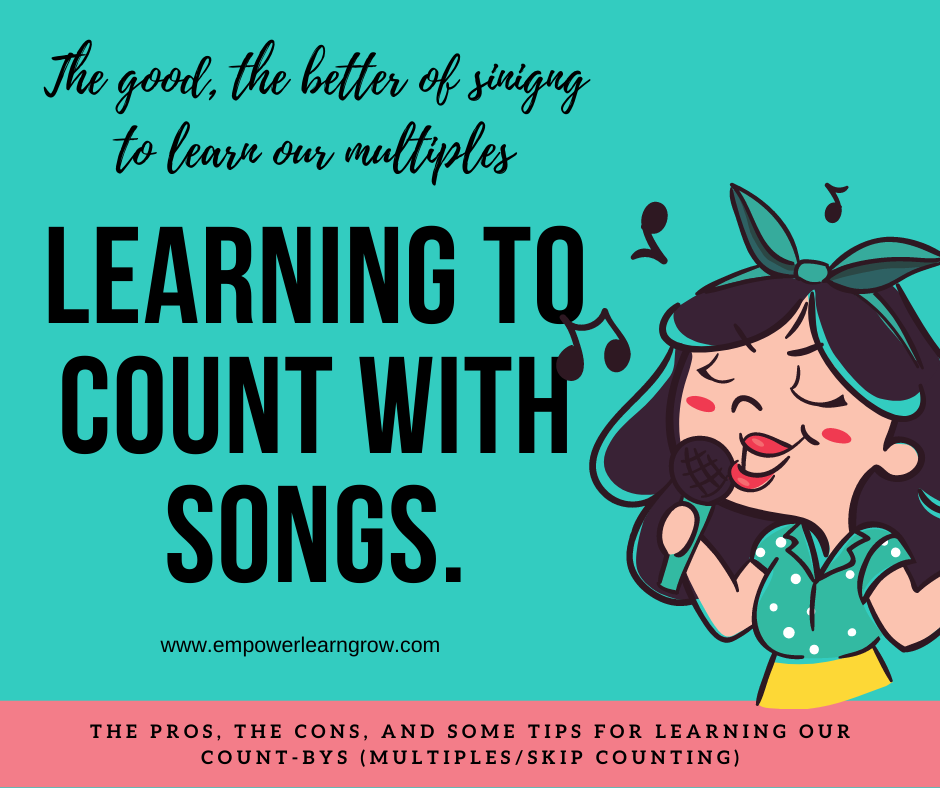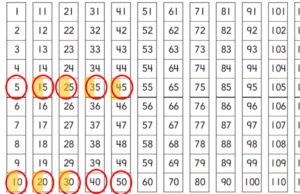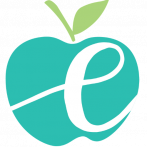
06 Sep Skip Counting with Songs: The Good and the Better
If you sing it, they remember it.
Right?
I’m a big believer in songs in math class. My sister used to make fun of me and said I had a song for everything.
Lining up,
Cleaning up,
Subtracting,
Multiplying,
Rounding,
Verbs,
Prepositions,
You get the point….
Ironically, I can’t carry a tune for my life, but I sure love putting learning to songs.
However, I’ve recently begun to change my mind about using songs to specifically teach skip counting, or learning multiples.
I have created a list of pros and cons and a few gentle suggestions on ways to improve this practice.
Pro:
- They remember the multiples. A quick internet search will show you easily that you can learn your 2s to the tune of Jingle Bells, your 4s to the tune of Row, Row, Row your Boat, your 5s to the tune of Happy Birthday, etc. I’ve been in plenty of classrooms who teach these songs and students pick them up quickly! They are great for transition work and kids really do know their multiples.
Con:
- They seemingly only know the multiples if they sing the entire song. This is where the thinking breaks down for me. To learn the quick list of multiples. Sing the song. But, if this is their ONLY way of knowing multiples, then we need to pack some new tools into our toolboxes.
When we teach students multiplication and division the first idea is to count all. We do this with equal groups of circles and stars, rows and columns, etc. Students learn quickly that they can find the total to 9X6 by counting by 6’s instead of counting by ones. This is the second counting level, Counting On.

As many teachers in the upper grades will tell you, knowing their multiples (count-bys) is critical in much of the work we will do with the upper-grade standards. It impacts fractions, multi-digit multiplication, division, reasonability, and more. But, it isn’t very helpful to us when they have to sing the entire song to know that 24 is the common multiple of both 6 and 4.
Singing isn’t helpful as students move from the Count On counting level to the Derived Strategy level. We don’t want the only strategy kids to have for multiplication and division to be the count bys. Our goal is to push them to derived strategies. It starts with count-bys, but it doesn’t end there. Many of us have stopped instruction at the count by level and leave it up to the song to answer each new equation.
For example:
9 x 6. I can count by 6s, 9 times. I can count by 9s, six times. Or, I can be pushed to that final counting stage and think,
Well, I know 9x 5 = 45, I just need one more 9. Many call this the building on strategy.
But let’s find the answer….
ummm.
ummmmm
Let me sing the whole song to remember what multiple of 9 comes after 45.
And there lies the issue. If students lack understanding of what skip counting actually is, they have no idea how to quickly get from 45 to 54 without singing the song.
It is important that students can start at ANY multiple and count forward by the desired number. They can start at 42 and count on by 7s. They can start at 54 and count on by 6s.
Here’s what you can try.
- Practice singing the song starting in the middle. “Count by 5’s starting at 35.” Do they know the beat or the place in the song to start? If not, consider sometimes singing the song and sometimes not singing, specifically when you are asking them to count starting not at the beginning. We need to incorporate this into our counting WAY more often. Students should get lots of exposure to counting starting at different numbers. Even our first graders should be counting by 10s, but not just on 10. Start at 50 and count by 10s. Start at 4 and count by 10s. When we understand counting patterns, we can count forward or backward by any number.
- Be sure to practice patterning. I love singing. I love counting. I really love doing both during transitions to capitalize on time. However, I have to remind even myself that this needs to be paired with opportunities for students to ‘see’ the count as they are counting. Recording the count helps to them see the patterns and when paired with a conversation of the patterns, students create better and more efficient ways to count on (“I can just add ten each time and subtract 1…It’s just 1, 2, 3, 4, in the tens place, and 0, 5, 0, 5 in the ones place.). Understanding the patterns will help them move to the Derived Strategy counting stage.
 I really love the counting charts created by Teresa Wills on Google Slides. I’ve modified her tools for google slides and added the 120 chart to help students see the patterns in relation to the other numbers. Using the color-coded features of this slide really helps draw attention to what students notice and help everyone to ‘see’ the same thing. I highly encourage you to spend just as much time with counting patterns as you do singing your songs.
I really love the counting charts created by Teresa Wills on Google Slides. I’ve modified her tools for google slides and added the 120 chart to help students see the patterns in relation to the other numbers. Using the color-coded features of this slide really helps draw attention to what students notice and help everyone to ‘see’ the same thing. I highly encourage you to spend just as much time with counting patterns as you do singing your songs.
I wanted to give you the slide I recreated here. It is so useable for every grade s K-6.

What strategies do you use? What have you found success with?


Sorry, the comment form is closed at this time.